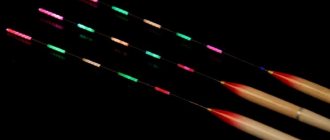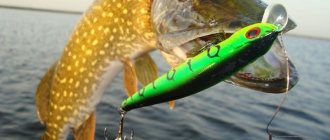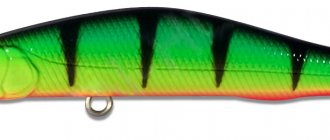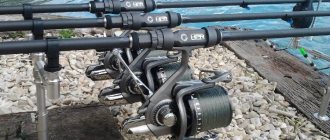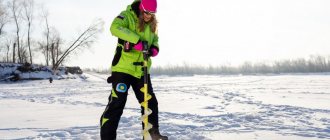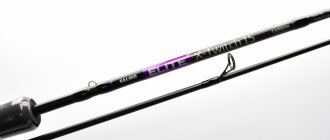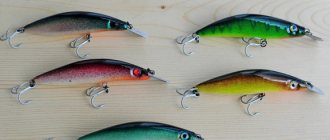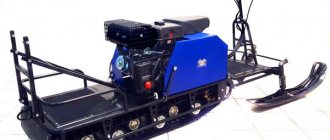Yuri 09/10/2020 271
In hot summer weather, a thermocline forms on lakes and ponds, an unknown phenomenon that has a significant impact on fishing. This phenomenon is observed in lakes and other stagnant bodies of water in the warm season. High air temperature heats the water; the heated upper layers of water have a density less than the lower layers.
The current in the river mixes the water and equalizes the temperature; in a lake or pond there is no current. Moreover, ponds with standing water are surrounded by trees and reeds, and even a strong wind does not stir the water. Under such conditions, the upper layers of water are several degrees warmer than the water at the bottom.
Temperature stratification of water greatly influences the behavior of fish. What should an angler do and how to catch fish in such conditions?
The essence of the term
Essentially, a thermocline is a middle layer of water with variable temperature, the difference at the upper and lower boundaries of which can reach ten degrees. It is formed due to the influence of three natural factors:
- solar heating;
- wind;
- change of day and night.
A thermocline is formed in mid-summer in stagnant bodies of water, where there is no important factor influencing the life of fish - current. Thus, the conversation can be conducted about the following locations:
- pond;
- lake;
- career;
- reservoir;
- quiet river bay;
- oxbow river bed.
Education process
Let us consider the process of thermocline formation in more detail.
Attention! The highest density of water is observed at a temperature of 4 degrees Celsius.
When the spring sun melts the ice, active mixing of layers begins in the reservoir. The upper water becomes heavier and sinks closer to the bottom, while the lower water rises. This phenomenon, also called reverse stratification, occurs until the temperature reaches four degrees and levels out throughout the entire thickness.
With a further increase in temperature, natural mixing does not occur due to the fact that the density of water stops increasing, but naturally decreases. The so-called direct stratification occurs, when the deeper, the colder.
Now let's look at the influence of wind. Under its influence, the water in the upper layer is mixed and equalized in temperature. At the same time, its effect on the bottom horizon is zero; it remains just as cold there.
Between the layers there remains a thin strip of water with variable temperature, constantly decreasing with depth. It is this horizon that scientists call the thermocline.
Thus, in a summer reservoir we see the following picture:
- First comes the top, warmest layer, with a temperature approximately equalized throughout the thickness.
- Then there is a thin boundary layer - a thermocline, within which the temperature changes sharply from warm at the top to cold at the bottom.
- The lower, deepest and coldest layer, in which the temperature uniformly drops with increasing depth.
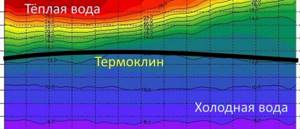
Approximate distribution of water at different temperatures at the thermocline
Scientists call the upper layer the epilimnion, the thermocline the metalimnion, and the lower layer the hypolimnion. Translated from Greek, these terms mean:
- Verkhneozerye;
- Sredneozerie;
- Nizhneozerye.
Important! In bodies of water where the influence of wind is minimal: steep banks, dense vegetation, a thermocline almost never forms.
There is also no thermocline in shallow ponds and bays, where wind mixing affects the entire water column and temperature stratification is not observed.
Where does the thermocline come from?
As you know, fresh water has its greatest density at a temperature of 4 degrees, and freezes at zero. This is why ice rises on the surface, and the entire thickness of water under the ice has a temperature of 0 to 4 degrees, with the warmest and, therefore, heaviest layers located closer to the bottom (Fig. 1).
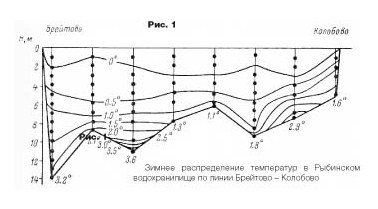
Of course, such a picture - it is called reverse stratification - is observed only in low-flow or stagnant reservoirs. Where there is a current, the water is mixed, and the temperature throughout the entire thickness is more or less equalized. In the spring, after the ice melts, the sun begins to heat the upper layers of water. They become heavier and fall down.
This mixing continues until the entire water column warms up to 4 degrees. With further heating, the density of water no longer increases, but decreases, and the warmer surface layers no longer sink down, but remain on top. A state of direct stratification sets in, when as you dive deeper, the thermometer will show an increasingly lower temperature.
The question is, how does the temperature drop evenly with depth or does it occur spasmodically ?
Let's try to simulate the processes that occur in the spring in the water column. To do this, take a fairly deep vessel with water, wait until the water in it reaches room temperature, and begin to heat its surface, for example, using a regular light bulb (Fig. 2a).
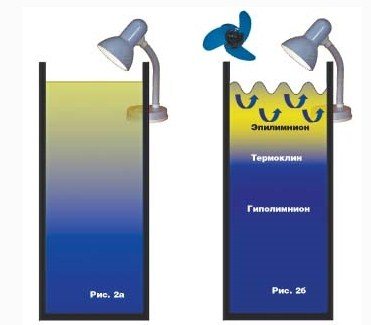
Receiving heat from the light bulb, the upper layers of water, due to diffusion, will give part of this heat down to the colder layers, and those, in turn, even lower, and as a result direct stratification will be established: the water temperature will drop evenly from the surface to the bottom vessel.
There are, however, other factors besides the density of water that can also interfere with the process (evaporation of water from the surface, thermal conductivity of the walls of the vessel, etc.), but our experiment is a mental one, and they will not interfere with us.
The described vessel with a lamp could well be compared to a natural reservoir, the surface of which is heated by the sun, if not for one difference. Most real bodies of water are, to one degree or another, influenced by winds that mix the surface layers of water, and this mixing has very important consequences.
Let's add a fan to our model and see what happens to the water in the vessel if the wind starts blowing on it.
Under the influence of wind waves, the upper layers of water will begin to mix (Fig. 2b), and the temperature within these layers will level out. But below this mixing zone, in that part of the vessel where the wind does not reach, the picture will remain the same: the temperature there will drop uniformly towards the bottom. Thus, with the help of a light bulb and a fan, we created three layers of water in our experimental vessel, which differ sharply from each other in temperature parameters.
- The top, warmest layer, with approximately the same temperature throughout its entire thickness.
- The lower, deepest and coldest layer, in which the temperature drops evenly towards the bottom.
- A thin boundary layer located between the first and second, within which the temperature changes sharply from warm at the top to cold at the bottom.
This boundary layer, inside which a temperature jump occurs, is nothing more than a thermocline, or, as it is often called, a temperature jump layer. The layer of water above the thermocline is usually called the epilimnion, the layer below the thermocline is called the hypolimnion , and the thermocline itself is sometimes called the metalimnion .
All these terms have Greek roots and literally, although not very euphoniously, they can be translated as “upper lake”, “lower lake” and “middle lake”.
So, as follows from our mental experiments, for a thermocline to appear in a body of water, two main conditions are necessary:
- Sunny warmth.
- Wind.
If there is no wind, or if the reservoir has high banks that well protect its surface, then mixing of the upper layers of water will not occur, and its temperature will fall evenly, without any jumps, towards the bottom - a situation that is reflected in Fig. 2a.
Important clarification
In fact, some mixing of the upper layer of water can occur without any wind. As a result of its cooling at night or when warm weather changes to cold.
Indeed, when water on the surface cools, its density increases, and it begins to sink down until it reaches layers with the same temperature (and density). At the same time, the underlying, still warmer layers are “squeezed out” upward in order to then also give up their heat to the night air and, in turn, sink lower. With the return of heat, everything repeats only in the reverse order.
Thus, the alternation of day and night, or hot and cool weather, also causes mixing of the upper horizons of the water column. But this process does not extend to a significant depth and its role, compared to wind mixing, is small. However, the sun and mixing of the upper layer of water are conditions, although necessary for the appearance of a thermocline, but not sufficient.
In this sense, the depth of the reservoir also plays a decisive role. As is easy to understand by looking, for example, at Figure 2b, it should be greater than the depth to which wind mixing penetrates. Otherwise, there is simply no room left for the thermocline layer.
Thermocline development
The formation of a thermocline in water bodies in the middle zone begins around the end of May. At first, its upper limit is at a depth of 1.5-2 meters. Many people have noticed when swimming that at a certain horizon the water clearly becomes colder.
As summer progresses, in most reservoirs the thermocline drops to a significant depth. So, for example, in Lake Onega by the end of summer its upper boundary is sometimes at depths of 30-50 meters.
On the other hand, where serious winds blow in summer and there are huge surface areas, as on the Rybinsk Reservoir, the thermocline sometimes collapses at depths of up to ten meters. Only deeper than this meaning does the situation remain normal.
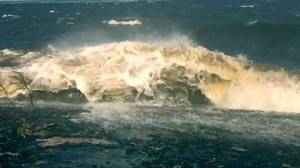
A storm on the Rybinsk Reservoir is capable of mixing layers to great depths.
From the above, we can conclude that the thermocline is very mobile, and it is impossible to determine its location “by eye”. It is necessary to make constant measurements with a water thermometer or use an echo sounder with thermal indication.
Thermocline transformations
In water bodies in the middle zone, the thermocline usually occurs in early June. The depth of its “occupation” (thickness of the epilimnion) is initially small. For example, in Lake Glubokoe near Moscow it is 1.5-2 meters, in Lake Pleshcheyevo - 2-4 meters. However, as the epilimnion warms up during the summer, the thermocline gradually sinks deeper. So, in Glubokoye by September it plunges to a depth of 7-8 meters, in Lake Pleshcheevo - to 10-12 meters, and in Lake Onega by the end of summer the upper limit of the thermocline can pass at a depth of 30-50 meters. The thickness of the thermocline itself averages 3-4 meters. The temperature difference at its upper and lower boundaries can reach 10 degrees or even more.
Although the presence of winds is necessary for the formation of a thermocline, the same factor can destroy it. For example, in the Rybinsk Reservoir, due to frequent strong winds and huge open spaces, water mixing penetrates to significant depths and usually destroys the thermocline in those areas where it has managed to form. If the wind is not too strong or does not blow for long, its effect is manifested in the fact that the thermocline zone drops lower.
A good illustration of the “life” of the thermocline can be found in measurements taken by hydrologists at the Rybinsk Reservoir in 1956. Spring was late then, and complete mixing of water was established in the central part of the reservoir only on June 1-2 at a temperature of 6-9 degrees. On June 3, intensive heating of the upper layers began, and on June 4, a thermocline appeared at a depth of 1-1.5 m, which by June 7 had already dropped to a depth of 3-4 m. On June 10, a strong wind, over 4 points, began, which caused intense mixing of water, which contributed to the lowering of the thermocline even deeper - to 7-8 meters. By June 13, the entire water column in sections of the reservoir up to 8 m deep had the same temperature of about 15-19 degrees, and no temperature jump was observed there. However, in areas with depths of 10 m or more, the water remained no warmer than 10 degrees, and there was a well-defined thermocline, the upper boundary of which was at a depth of 8-9 m.
In other words, the temperature stratification of water in a reservoir is a very mobile system. Its parameters - the thickness of the layers and temperature differences within and between them - can quickly change under the influence of weather factors and even simply as a result of daily fluctuations in air temperature.
Echo sounder operation
The thermocline on an echo sounder with a temperature sensor is very clearly visible. However, its border may appear somewhat blurry. This is not surprising, because the process of mixing water does not stop.
Moreover, the influence of the engine propeller, produced while moving across the water area, was added to the wind effect. The more fishing and pleasure boats there are in a reservoir, the more actively the water in the epilimnion mixes, and the lower the thermocline boundary drops.
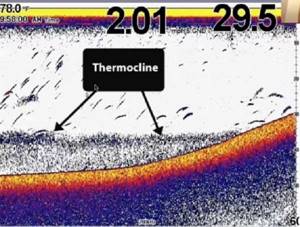
Displaying the thermocline on the echo sounder screen.
Effect on fish
Ichthyologists and fishing enthusiasts who have good echo sounders know that mostly in summer, schools stay above the temperature jump zone. This is partly due to the fact that water can cool significantly with depth; they write that even 10 degrees per meter is not the limit.
Therefore, when fish overcome layers with different temperatures, they naturally experience some discomfort. This brings less unpleasant sensations to some species, for example, vendace or smelt, while others tolerate sudden temperature changes much worse.
The second significant factor of the thermocline is the presence of dissolved oxygen in the water. The most important gas for breathing comes from the atmosphere when the upper layers are mixed by the wind or as a result of photosynthesis of aquatic plants.
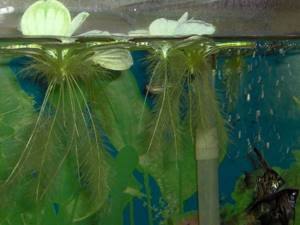
The aquatic plant even supplies oxygen to the aquarium.
Peculiarities of fish biting during the new moon in summer
Both sources of oxygen act mainly in the surface layer of water. Below, the wind does not work, and the plants are not able to receive enough sunlight.
It is because of this that in the lower part of the reservoir, in the hypolimnion and thermocline, many fish experience oxygen starvation and rise closer to the surface of the water. Predators concentrate in the upper layers of snags, peaceful fish rise to the shallows or to single navels at the bottom of the reservoir.
It must be taken into account that the thermocline boundary is not the same over the area of the reservoir and is not tied to its depths; it does not run parallel to the bottom or surface. Therefore, fish easily find places above the oxygen-poor zone; an echo sounder helps us find such areas.
Thermocline. What it is?
The water column of lakes is divided into epilimnion, metalimnion and hypolimnion (“limnos” - from Greek - lake). That is, the upper, middle and lower layers of the lake. The limits are determined depending on the water temperature. In summer, the epilimnion is usually warm with the same temperature throughout the layer. Only in its lower part it decreases a little. The temperature in this layer in mid-summer reaches 20-25 degrees. In the lower part of the lake (in the hypolimnion), the temperature is also even and the same, but very cold, within 5-6 degrees. At times it may be a little lower.
In the middle part of the lake (metalimnion), the water temperature drops abruptly. In the upper part of this layer it can be within 20°C (the same as in the epilimnion), and after 3-5 m it is already 7-10°C, or even lower. So, for example, in Glubokoye Lake (Moscow region) the temperature drops from 20 degrees to 10°C. The biological station “Deep Lake” is located on this lake, which was founded in 1891. All this time, hydrobiological work has been carried out there. It belongs to the Institute of Ecology and Evolution. A.N. Severtsov RAS.
Due to the difference in water temperature, a thermocline is formed. The thickness of the metalimnion can reach 3-7 m or more, depending on the heating of the water. The hypolimnion begins in mid-summer from 7-10 m to maximum depth. In Lake Glubokoe - to a depth of 32 meters.
Water has an anomalous property, low thermal conductivity. It warms up from above due to the sun's rays and slowly releases heat to the underlying layers. Therefore, the water column of the lake warms up very slowly.
Such a clear stratification is observed in reservoirs in which there is no mixing of water due to currents or wind waves. Lake Glubokoe has a small area (about 60 hectares), is surrounded by forest and is slightly exposed to wind. In large bodies of water, the thermocline can be eroded due to mixing of waters.
In spring, under the influence of sunlight, the ice begins to melt. The rays, passing through the ice, heat the topmost layer of water, which gives off heat to the ice nearby. So the ice melts both above and below. In central Russia, water bodies are freed from ice in the second half of April or early May, depending on the weather.
The water continues to gradually warm up, soon reaching a temperature of 4°C. It should be noted that water has another anomalous property. The highest density of water is observed not at 0°C, but at 4°C (to be more precise, at 3.8°C). At this temperature, water is at its heaviest (dense). The underlying layers of the lake have a temperature of about 3-5°C or slightly lower.
As a result, heavy water, like an avalanche, rushes down, displacing water from the underlying layers. Spring mixing of waters occurs. The lower layers of the lake are enriched with oxygen, and the water column, including the upper layer of the lake, is enriched with minerals. At the bottom of the lake in winter, settled organic matter (detritus) is destroyed and mineral salts are released into the environment. Unwanted gases such as methane, hydrogen sulfide are also removed from the deep layers of water by stirring. Sunlight and mineral salts promote the development of microscopic algae, which enrich the epilimnion with oxygen. In early spring, mainly cold-loving algae develop.
The water gradually warms up during spring and summer, finally reaching 20-25oC. This happens at the end of July or early August. At this time, you can comfortably swim, dive, and frolic in the water. Sometimes, when we lower our legs, we feel cold with them (cold layers). Uninformed people say that this is due to the springs (springs) that flow in this place. In fact, when swimming, we reached the cold thermocline with our feet.
The epilimnion slowly gives off heat to the underlying layers. Warm water, being less dense, lies on cold and more dense water. This results in a flaky cake. Of course, with strong wind waves, these layers may mix and such obvious separation may not occur.
In central Russia, the temperature of water bodies usually rises until the beginning of August, and then begins to fall again. The first days of August fall on Elijah's day (Elijah the prophet). Ilyin’s Day is considered the calendar boundary of summer, when the first signs of autumn appear in nature (including in water bodies). In Russia it is believed that “On Ilya before lunch it’s summer, and after lunch it’s autumn.” And also “Before Ilya, the man bathes, and with Ilya he says goodbye to the water.” Because of this, according to popular belief, starting from August, you cannot swim. From August the water begins to cool, and by mid-September it drops to 10°C. Of course, you can’t swim in such water, it’s too cold.
Finally, the water temperature drops to 4°C by early to mid-October. The water becomes denser again and falls down like an avalanche. Another, but already autumn, mixing of waters is taking place. The temperature of the lake levels out, and unwanted gases that accumulated in the bottom layer over the summer are mixed with the bulk of the water or released into the atmosphere. These are mainly methane, hydrogen sulfide, which are toxic to living things. Enriched with oxygen, the water in the deep layers becomes suitable for life. This happens year after year.
The upper layer of the lake is enriched with oxygen mainly due to the vital activity of phytoplankton. Photosynthesis is sometimes so intense that excess oxygen does not have time to escape into the atmosphere. The water becomes like soda. In the absence of excitement, if you lower your hand into the water and make a sharp movement with it, gas bursts out of the water, like from a soda bottle. Carbon dioxide is released from carbonated water, and oxygen is released from the lake.
Planktonic organisms living in a reservoir sooner or later die off. Many of them live from a few days to one month or a little more. These are microscopic algae, bacteria, zooplankton and others. As they die, they slowly settle in the water column. The smaller the particles, the slower they settle. Animals, in particular crustaceans and fish, excrete excrement during their life, which also settles to the bottom. Bacteria living in the water column and at the bottom mineralize incoming organic matter, releasing mineral salts.
The destruction (rotting) of organic matter occurs with the consumption of oxygen. At the bottom there is nowhere for it to come from, because enrichment occurs only in spring and autumn. This leads to the fact that the amount of oxygen gradually decreases, from the bottom to the surface. And by the beginning of summer (after the spring mixing of waters), an oxygen-free zone may form at the bottom, which gradually spreads to the higher layers of the lake. Ultimately, by the end of August – beginning of September, the anoxic zone can reach 1/3 (sometimes even ½;) of the lake’s thickness.
During the summer, a large amount of organic matter enters the bottom of reservoirs (due to the death of aquatic organisms, leaves, or all kinds of pollution), so in winter the entire thickness of the lake can be deprived of oxygen. This leads to starvation and death of a large number of fish and other aquatic organisms. They can only be saved by ice holes, or by enriching the water column with air. Only spring or autumn mixing of waters can improve the situation.
The autumn and spring mixing of waters can be compared to breathing. When you exhale, unwanted gases are removed, the gas composition of the lake is leveled, and when you inhale, the deep waters are enriched with oxygen.
What happens in the metalimnion? There is a sharp temperature drop in this layer. In particular, in Lake Glubokoe it can reach 10-12 degrees. In the epilimnion, down to a depth of 7-8 m, the temperature is approximately even, 18-24 degrees. At a depth of 10 m and below, it is also flat, but much colder, about 5-6 degrees. In an average 4-5 meter layer, the temperature difference is 10-12 degrees. The warm water of the epilimnion seems to lie on denser cold water.
Dead organisms, shells of crustaceans that they shed when molting, excrement, etc. settle in the thickness of the lake. The sizes of these particles are small (within several tens of microns), and they settle in the water column very slowly. The thermocline prevents the settling of particles. The temperature jump layer differs from the overlying layers of water in its increased density, which helps to retain small particles in it that settle at an already low speed. In this regard, the presence of a large number of different particles is observed in the temperature jump layer, especially after the algae die off. They seem to lie in this layer, gradually decomposing under the influence of microorganisms. Because of this, the metalimnion is figuratively called the second bottom. If you take water from this layer with a special device (bathometer), you can detect the suspension with the naked eye. And under a microscope, flakes of stuck together particles are observed. The settling suspension is called detritus (from the Latin - “worn out”).
The presence of a large amount of organic substrate and oxygen in the metalimnion creates favorable conditions for the life of bacteria, and accumulations of food particles attract zooplankton (crustaceans, rotifers, protozoa) to this layer, which, together with bacteria, takes part in the mineralization of organic matter and oxygen consumption. Its amount in this layer decreases sharply. Intense destructive processes in the metalimnion lead to the appearance of a metalimnion minimum of oxygen in this layer. This phenomenon is clearly visible in Lake Glubokoe. An interesting situation arises: in the epilimnion the amount of oxygen is large, in the hypolimnion it is also sufficient, but in the metalimnion it decreases to minimal values (almost to analytical zero).
The decomposition of organic matter leads to the enrichment of this layer with mineral salts, which are always insufficient in the water, especially in the second half of summer. Algae descend to a depth of 4-6 m to gain access to minerals. At these depths there is little light, not enough for full photosynthesis, but algae gain access to mineral salts.
In Lake Glubokoe, photosynthesis occurs predominantly in the upper two meters, but the bulk of algae is located at a depth of 5 m, above the temperature jump layer, where, apparently, biogenic elements are present in sufficient quantities. In this layer, the biomass was dominated by blue-green Coelosphaerium kuetzingianum, Microcystis aeruginosa, Oscillatoria agardhii, green Sphaerocystis polycocca and dinophyte Peridinium cinctum.
Intensive destructive processes in the metalimnion led to almost complete use of oxygen in this layer: in mid-August its amount decreased to 0.2-1.5 mg O2/l, while in the upper part of the hypolimnion it remained at a level of 4 mg O2/l.
Sadchikov Anatoly Pavlovich,
professor, vice-president of the Moscow Society of Natural Scientists
Fish behavior during the thermocline
The activity and bite of fish in the summer directly depends on the development of the thermocline in a particular reservoir. Below we will consider the influence of this factor on the most popular types.
crucian carp
Despite the fact that crucian carp is not very demanding on living conditions, and the thermocline period is not the most favorable for it. In hot weather, it tries to stand closer to the bottom in cool water, going out to feed in shallow water at dawn and dawn.
Attention! Sometimes crucian carp reaches the upper layers of warm water, where it can be successfully caught.

Crucian carp among coastal thickets of aquatic vegetation. Here a thermocline does not form, and the fish feels relatively comfortable.
Zander
Pike perch, unlike crucian carp, loves clean water, but its behavior in summer is largely similar. He prefers to wait out the heat of the day in cool water below the thermocline. Therefore, it is mainly caught during daylight hours with deep-sea jig baits.
The pike perch comes out into relatively shallow water following the small fish at dawn and stays here until dawn. At this time, it can be successfully caught using spoons or wobblers.
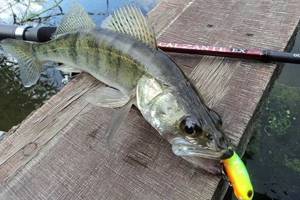
Morning dawn is the best time to catch pike perch using a wobbler.
Pike
The thermocline affects pike less than other fish. For her, the availability of food is more important. Therefore, in summer there is the most obvious division of the toothed into the grass and the deep. The first one watches for small things near thickets of aquatic vegetation, the second one lies in ambush near various bottom anomalies.
Attention! In cloudy weather and light rain, pike can hunt in any layer of water.
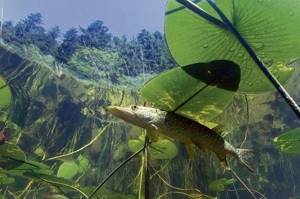
Pike likes to set up ambushes among thickets of underwater vegetation.
Perch
During the thermocline period, perch can be found in any layer. In this case, a pattern is observed:
- small sailors stand closer to the surface;
- humpback whales hunt closer to the bottom;
- at dusk, both come closer to the coastal aquatic vegetation and can be located in any layer.
During the thermocline period, the best baits for perch are spinners. They can be carried out in any water horizon and quickly detect a school of fattening predator.
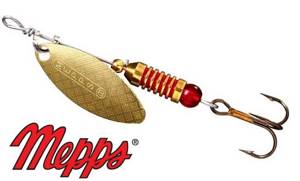
Mepps Aglia #1 is the most popular spinner bait for perch.
Roach
Silver beauty almost always stands below the thermocline in those reservoirs where it is present. It is important for her to change the terrain where food particles accumulate. In rivers and small lakes where a thermocline does not form, roach prefers places near reeds, cattails, and reeds.
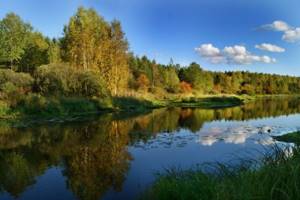
If there are trees on the shore that cast a shadow on the water, a flock of roaches can quite expectedly stand under them.
Rudd
The rudd, unlike its closest relative, is a pelagic and heat-loving fish. Therefore, you need to look for it at the water surface above the thermocline. Here she picks up small insects and other food that falls into the pond from above.
Attention! In summer you should look for rudd at the edge of aquatic vegetation in the upper layer of water.
Where did all the fish go?
The fish body reacts differently to the thermocline. Crucian carp, which leads a bottom lifestyle, is not picky about water quality; during the day it can stay in the lower layer of water, and in the evening it goes to a shallow area in search of food. Most often, it can be found at a depth of about 1 meter. In such shallow places, there is no thermocline. Poking around in the mud on the shallows near the shore, it bites well and is successfully caught.
In hot weather, carp and carp hide in thickets of grass or reeds; in such places there is also no great depth and therefore the entire water column is saturated with oxygen. If the angler does not have the opportunity to cast gear to the border of the reeds and open water, you can break out a passage in the reeds in advance and cast there. At such times, there is no need to look for carp in deep places. In cold water, with a lack of oxygen, there is no food supply in the muddy soil. Carp also loves the confluence of springs and streams, just like bream, it hangs around in this area in the heat.
The heat-loving rudd always stands above the thermocline, in the upper layer of water. This is where she eats. At such times, it is successfully caught by leaving the bait in the water column.
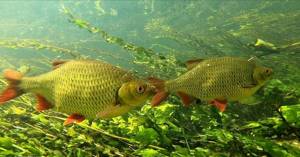
Fans of chub fishing should look for it in rivers and currents. It is not found in stagnant bodies of water.
The thermocline has no effect on pike and perch, they calmly tolerate temperature differences, they are located where the fry are. Small and medium-sized specimens hunt in the grass near the shore, large specimens sit in ambush in the depths. Predators rest in cool water near the bottom. There is enough oxygen for rest; they rise above the thermocline to actively hunt.
It is difficult for pike perch to tolerate very warm water. During the day you need to look for it at the bottom, in cool water. At night he goes out into shallow water to catch fry. During the day it is well caught with jig baits, and at night wobblers work in the shallows.
